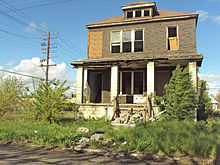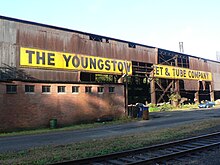User:Carlson0712/sandbox
Interventions[edit]
Different interventions are adopted by different city governments to deal with the problem of city shrinkage based on their context and development. Governments of shrinking cities such as Detroit and Youngstown have used new approaches for interventions rather than economic incentives for boosting populations to previous level before shrinkage. Below are several approaches that different city governments have been adopted.
Green Retirement City[edit]
A research from Europe proposes that retirement migration can be used as one of the strategies to deal with city shrinkage. “By converting vacant space or improving access to high quality green space, shrinking cities can attract retirees in search of quality of life”.[1] Abandoned properties or vacant lots can be converted into green spaces for the retiring seniors migrated from other places. Migration of older individuals could bring their knowledge and savings to the city for revitalization.[1] Retiring seniors are often ignored by the communities if they are not actively participating community activities. The green retirement city approach could also have benefits on social inclusion of seniors, such as urban gardening.[1] The approach could also act as a “catalyst in urban renewal for shrinking cities”.[1] Accommodations, in the meanwhile, have to be provided including accessibility to community facilities and health care.
Establishing green retirement city would be a good approach to avoid tragedies like the 1995 Chicago heat wave. During the heat wave, more than hundreds of deaths were found in the city, particularly in the inner neighborhood of the city. Victims were predominated by poor, elderly, African American population living in the heart of the city.[2] Later research pointed out that these victims were socially isolated and lack of contact with friends and families.[2] People who were already very ill in these isolated, inner neighborhoods were also affected and might die sooner than they might be.[2] Some of them were died not Some of them wanted to be independence and did not live with their family.[3] The high crime rate in the inner decaying city also accounted for the high rate of death as they were afraid to open their windows.[3] Therefore, a green retirement city with sufficient community facilities support would accommodate needs from elderly population isolated in the poor, inner city communities.

Right-Sizing[edit]
The idea of “right-sizing” is defined as “stabilizing dysfunctional markets and distressed neighborhoods by more closely aligning a city’s built environment with the needs of existing and foreseeable future populations by adjusting the amount of land available for development.” [4] Rather than revitalize the entire city, residents are relocated into concentrated or denser neighborhood. Such reorganization is encouraging residents and businesses in more sparsely populated areas into more populated areas.[5] Public amenities are emphasized for improvement in these denser neighborhoods. Abandoned buildings in these less populated area are demolished and vacant lots will be reserved for future green infrastructure.[4]
The city of Detroit adopts such approach in their “Detroit Work Project” plan. Currently, twenty Detroit neighborhoods are only 10%-15% occupied.[6] The plan encouraged people to concentrate themselves in about nine neighborhoods from two-third of Detroit.[6] In the plan, the city performed several tasks including prioritizing public safety, providing reliable transportation and performing demolition plans for vacant structures.[7] Houses in the remaining one-third might eventually be demolished for new projects such as urban farms.[6]
Although the "right-sizing" approach may seem attractive to deal with tremendous vacant lots and abandoned houses with isolated residents, it may be a problem for people who may not be able to move to these denser neighborhoods.[5] In the case of Detroit, although residents in decaying neighborhood will not be forced to move to concentrated area, area outside designated denser neighborhood may not get the kind of services they require.[5] There is a lack of financial support to residents to move while the plan indirectly abandoned poor communities. Neighborhoods that are surrounded by heavy industries are also ignored in the approach. The idea of right-sizing may cut off connection of resources to these communities, particularly a “shortage of health-promoting amenities” and “suffer from dearth of health-promoting resource” including access to healthy food and green spaces.[8] Communities in shrinking cities often are low-income communities where they are segregated.[8] Such segregation and exclusion may “contribute to psychosocial stress level” as well.[8] With most of the contextual background of shrinking cities as decaying industrial cities, segregation with bad environment and pollutants remained may further add burden to the quality of living environments of these communities.
Smart Shrinkage[edit]
The idea of “smart shrinkage” is similar to usual economic incentives that encourage economic activities and investment to boost up population and revitalize the shrinking cities economically. Rather than believing the city can return to previous population size, the governments accepts themselves as a smaller city and the population will not go back again.[9] Instead, the government puts more emphasis on diversifying economy and prioritizing funds, and less on relocation of people and homes.

“Youngstown 2010” is an example of such approach for the city of Youngstown. Besides of relocating population into more vibrant neighborhood, the plan also diversifies the city economy “which used to be almost entirely based on manufacturing”.[10] Tax incentive programs like Youngstown Initiative “have assisted in bringing in and retaining investment throughout the city.”[11] It helps to attract and preserve investment throughout the city. Since the plan was proposed, many major investments have been made in the city. The downtown of Youngstown has been also transformed from a high crime rate with less circulations into a vibrant location with restaurants and business.[10]
Nevertheless, the smart shrinkage approach may worsen the isolation of residents who cannot move to more vibrant neighborhoods. In particular, segregation may result in the shrinking industrial city, where economy is diversified through reinvestment of polluting industries while worsening the existing living environment. Environmental justice issue may exist from the approach if the city government ignores the types of industry that are planned to reinvest and the neighborhood that are segregated.
Land Bank[edit]
Lank bank is often a quasi-governmental county or municipal authority that manage with the inventory of the surplus vacant lands. They “allow local jurisdictions to sell, demolish and rehabilitate large numbers of abandoned and tax-delinquent properties.”[12] Sometimes, the state works directly with local governments to allow abandoned properties for easier and faster resale and discourage speculative buying.[12]
One of the famous examples would be the Genesee County Land Bank in the city of Flint, Michigan. As an industrial city with General Motors as the largest producer, declining car sales with availability of cheap labor in other cities led to reduction in labor force of the city. The main reason of the property or land abandonment problem in Flint was the state’s tax foreclosure system.[13] Abandoned properties were either transferred to private speculators or became state-owned property through foreclosure, which encouraged “low-end reuse of tax-reverted land” due to the length of time between abandonment and reuse.[13]
The Land Bank provides serious of programs to revitalize shrinking cities. In the case of Flint, Brownfield Redevelopment for previous polluted lands is controlled by the land bank to allow financing of demolition, redevelopment project and clean up though tax increment financing.[13] A “Greening” strategy is also promoted by using abandonment as an opportunity for isolated community to engage in maintenance and improves of vacant lots. [13] In the city, there is significant reduction in abandoned properties. Vacant lots are maintained by the banks or sold to adjacent land owners as well.[12]
Establishment of land banks could increase land values and tax revenues for further innovation of the shrinking cities. Nevertheless, The process of acquiring foreclosures can be troublesome as “it may require involvement on the part of several jurisdictions to obtain clear title”, which is necessary for redevelopment.[14] Economic problems that local resident have including income disparities between local residents cannot be solved by the land bank, with the addition of increasing rents and land values led by revitalization of vacant land. Local leaders are also lack of authority to interrupt works that Land Bank did.[13] Environmental justice problems that are from previous polluting industry may not be fully addressed through shrinking city intervention and without opinions from local people. Therefore, a new approach of dealing with these vacant lots will be to work with non-profit local community group to construct more green open spaces among the declining neighborhood to reduce vacant lots and create strong community commitments.[12]
Other Approaches[edit]
There are several other miscellaneous interventions that some cities have been used to deal with city shrinkage. One of the interventions would be the series of policies adapted in the city of Leipzig in East Germany. They include construction of town houses in urban areas and guardian houses with temporary rental-free lease.[15] Temporary use of private property as public spaces is also encouraged as well.[15] Another intervention would be revitalization of vacant lots or abandoned properties for artistic development and artists interactions such as the Village of Arts and Humanities in North Philadelphia, where vacant lots and empty buildings are renovated with mosaics, gardens and murals.
References[edit]
- ^ a b c d Nefs M, Alves S, Zasada I, Haase D, 2013, "Shrinking cities as retirement cities? Opportunities for shrinking cities as green living environments for older individuals" Environment and Planning A 45(6) 1455 – 1473
- ^ a b c Roper, R. E. (2003). Book Review of “Heat Wave: A Social Autopsy of Disaster in Chicago”. Journal of Homeland Security and Emergency Management, 1(1), 7
- ^ a b Schreuder, Cindy. “The 1995 Chicago heat wave” Chicago Tribune, July 13, 1995
- ^ a b Schilling, Joseph, and Jonathan Logan. 2008. “Greening the rust belt: A green infrastructure model for right sizing America’s shrinking cities”. Journal of the American Planning Association 74 (4): 451-466
- ^ a b c Davis, Lauren. “Detroit plans to shrink by leaving half the city in the dark” We Come from Future. May 26, 2012
- ^ a b c McGreal, Chris. “Detroit mayor plans to shrink city by cutting services to some areas” The Guardian. December 17, 2010
- ^ “Transforming Detroit Handbook” City of Detroit. Web. 5 March 2014
- ^ a b c Morello-Frosch, Rachel, Miriam Zuk, Michael Jerrett, Bhavna Shamasunder, and Amy D. Kyle, “Understanding the Cumulative Impacts of Inequality in Environmental Health: Implications for Policy,” Health Affairs 30, No. 5 (2011): 879-887
- ^ Rhodes, James and Russo, John. Shrinking ‘Smart’?: Urban Redevelopment and Shrinkage in Youngstown, Ohio, Urban Geography, 34:3, 305-326
- ^ a b Lawson, Ethan. “Youngstown: A Shrinking City with Big Ideas” CEOs for Cities. July 25, 2013
- ^ Parris, Terry. “Youngstown 2010: What shrinkage looks like, what Detroit could learn.” Model D. Model D, May 4 2010. Web. 6 March 2014
- ^ a b c d Fredenburg, Julia. Land Banks to Revive Shrinking Cities: Genesee County, Michigan, Housing Policy & Equitable Development, PUAF U8237, May 10, 2011. Web. 4 March 2014
- ^ a b c d e Gillotti, Teresa and Kildee, Daniel. “Land Banks as Revitalization Tools: The Example of Genesee County and the City of Flint, Michigan.”
- ^ “Revitalizing Foreclosed Properties with Land Banks” Sage Computing, Inc. August 2009
- ^ a b Wiechmann, Thorsten and Volkmann, Anne and Schmitz, Sandra. “Making Place in Increasingly Empty Spaces-Dealing with Shrinkage in Post-Socialist Cities-The Example of East Germany” Shrinking Cities-International Perspectives and Policy Implications, Routledge, New York, 2014

